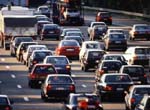 Gas prices, thanks to the Global War on Terror and Hurricane Katrina, are now the highest in the nation’s history. Gas easily tops $3 per gallon in San Francisco, Boston, Los Angeles, Miami, and other cities across the nation, making driving an expensive way to get around. For reference, gas prices have increased roughly 100% since 9/11.
Gas prices, thanks to the Global War on Terror and Hurricane Katrina, are now the highest in the nation’s history. Gas easily tops $3 per gallon in San Francisco, Boston, Los Angeles, Miami, and other cities across the nation, making driving an expensive way to get around. For reference, gas prices have increased roughly 100% since 9/11.
What’s the upside? That ridiculously expensive petroleum is prompting people to drive more slowly on highways, drive less often, buy more fuel-efficient cars, and take mass transit more often. A recent Congressional Budget Office report found that based on statistics from 2003 to 2006, a theoretical 15-year, 10% increase in gas prices would reduce consumption by 4% as consumers replaced their gas-guzzlers with more fuel-efficient cars.
And I do mean cars. Sales of light-trucks dropped 10% beginning in 2003, when the Iraq invasion made gas prices spike. Sales of compacts and mid-size vehicles, on the other hand, have been on the rise: the combination of more compacts and fewer SUVs means the average vehicle on the road today has a higher fuel-efficiency than three years ago.
Although the CBO report did not list the amount of CO2 saved by having fewer trucks on the road, it did say that a 20% rise in gasoline prices created a 2% increase in mass transit ridership and took 730 vehicles (per weekday) off the freeways. A bonus: the drivers on the roads drove more slowly.
Now, this may be a coincidence, but since gas prices went up, traffic fatalities for all vehicles (except SUVs) have decreased. Overall, 2006 (the most recent data year available) had the lowest traffic fatality and injury rate in five years, and most of the decrease was due to reduced accidents during daylight hours on weekdays (commute time).
So is the high price of gas making us safer? Indeed. With fewer commuter vehicles on the road, especially roll-over prone SUVs, and more people taking public transit, the facts suggest there’s less chance for accidents.











